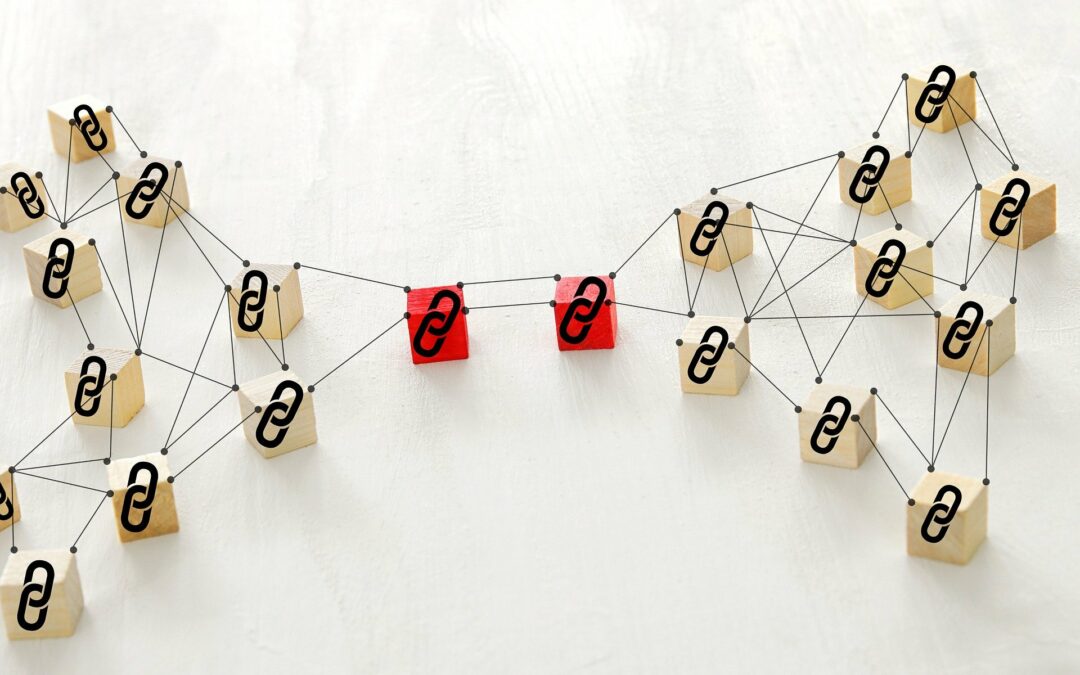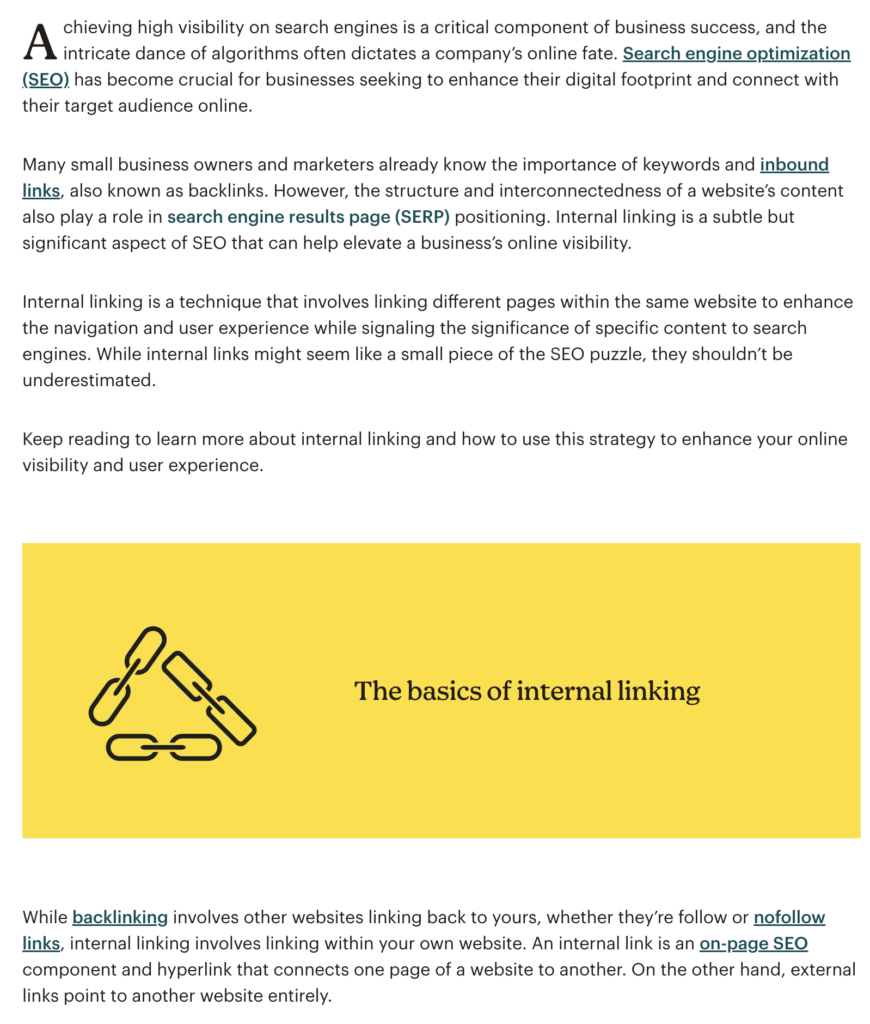When it comes to boosting your website’s search engine optimisation (SEO), internal links are an important component that shouldn’t be overlooked! This article will look at what internal links are and why they are an important but overlooked part of SEO.
But What are Internal Links?
They are links within your own website that connect different pages to each other. Adding these links is simple but powerful, and comes with a lot of benefits for both your readers and search engines. Let’s dive into why internal links are so helpful!
1. Help Search Engines Understand Your Website
Search engines, like Google, need to understand what your website is about in order to rank it in search results. Internal links can help them do this. By linking related pages together, you’re showing search engines how different parts of your website are connected. This makes it easier for Google to “read” your site and understand all about your brand, what your services are, as well as what your message is.
2. Guide Readers to Useful Content and Keep People on Your Site Longer
Internal links help your readers find other helpful pages on your site. If someone is reading about a topic and you link to another page that provides more information, you’re giving them a better experience. They’re more likely to stay on your website longer and explore other content, which shows search engines that people find your website valuable.
Another benefit of a longer visit is that the reader is more likely to come back to your website in the future for more information. Additionally, it improves your engagement metrics with lower bounce rates.
So, let’s take a look at a good example of internal linking on a website:
Mailchimp’s internal linking guide serves as a perfect example of how internal linking can be implemented on a web page. When they mention new terms that readers may not be familiar with such as backlinking or SEO, internal links to their guides covering those topics are provided. This shows how internal links can not only enable further reading for the visitor but also keeps them on your website longer.
3. Spread SEO Improvements Across Your Website
When a web page has a lot of links directed to it, the page can pass on some of its authority and value to other pages in a process referred to as “link juice.” This is a fancy way of saying that the page will generate more attention from search engines. By linking from your popular pages to other pages on your site, you can share some of that “link juice”. This can help boost the rankings across multiple pages instead of only one.
For example, if you have a blog post that covers a guide for a service your business provides, you can use internal links to guide the reader to your related service. This can transfer some authority and value from the blog post to your service.
Parent and child pages also provide an example of how link juice can work through internal links. If you have a parent page discussing different species of Africa’s big cats that has a lot of authority you can share the authority to related child pages such as leopards, lions and cheetahs.
The same goes for the other way around with the child page linking back to the parent page. In this case a reader viewing a page on lions would also link back to the parent page covering Africa’s big cats.
4. Improve User Experience
A large part of SEO is making your website enjoyable and easy to use for visitors. When you use internal links wisely, you’re helping readers find exactly what they’re looking for. This makes your website easier to navigate, and people are more likely to stick around if they can find what they need quickly. You also offer your audience the ability to dig deeper and inform themselves more about specific topics of interest.
5. Help Search Engines Find All Your Pages
Search engines use special tools called crawlers to find and index (or list) web pages in their results. These crawlers follow links from page to page, but they can miss pages if there are no links to them. Internal links help signpost other content on your website which enables crawlers to discover all parts of your site, ensuring more of your pages appear in search results.
6. Allow You to Target Keywords
When you use internal links, you can include keywords in the anchor text (the clickable text of a link).
For example, let’s say you run a business providing kitchen worktops and want to be found for the term “granite kitchen worktops”. In a blog post discussing the various pros and cons about each different kitchen worktop material, you could include this keyword term in the anchor text linking to your service providing granite kitchen worktops.
This helps search engines connect that page with those keywords, making it easier for people to find you when they search for those terms.
7. Increase the Value of Old Content
If you have older content on your website that still provides value, linking to it from newer pages is a great way to keep it relevant. These links bring fresh attention to old pages and can increase their visibility in search results. Plus, it’s a nice way to show readers that your content library has a lot to offer. Additionally, you can go back to older pages and refresh them with internal links that lead to new content that didn’t exist when the page was first created. It’s important to remember that a major part of SEO is keeping your content as relevant and up to date as possible.
Let’s look at a quick example of how this can be done:
Say you have written a new piece of content on new AI tech tools but you also have a previous article discussing predictions for AI tech tools, you could go back to the older article and update it with an internal link to the new post.
8. Boost Your Page Rankings
Each internal link acts like a “vote” for the page it links to, telling search engines that the page is trusted. When you have several pages linking to a specific page, it signals that the linked page is valuable, which can in turn improve its ranking. Over time, this can help boost your most important pages to the top of search results.
9. They Can Increase Conversion Rates
Building a strong internal link structure enhances user navigation and this can help guide your target audience to a sale. By carefully linking relevant content, especially for visitors in the early marketing funnel stages, you can lead them deeper into the funnel, increasing the likelihood of conversions.
For example, if you have pages where visitors can buy products, sign up for a service, or contact you, internal links that provide information for users in the “interest” stage of the funnel, can help guide readers further down the funnel toward those conversion pages. This can increase the chances of them taking the action you want, whether that is making a purchase or filling out a form.
It is important to keep in mind that when people can find the content they are looking for quickly and easily, they are more likely to stay on your site for longer which increases the chances of them becoming paying customers.
Tips for Using Internal Links
Link Naturally:
Only add links where it makes sense and feels natural. Don’t overdo it, as too many links can be overwhelming and off-putting for readers. It’s also better to avoid using the same internal link multiple times in quick succession as this can confuse the reader.
Use Descriptive Anchor Text:
Make sure the clickable text describes what the linked page is about. This helps both readers and search engines understand the link’s purpose.
For example:
Instead of writing:
“Learn More”
Try being more specific such as:
“Read our SEO guide”
Try and think about it from a user’s perspective, in this case “learn more” doesn’t inform them what they are learning about or where the link will lead.
Keep It Relevant:
Only link to pages that relate to the current page. Forcing links to un-related pages can feel un-natural and put off your readers, let alone Google.
Audit Links Regularly:
Make sure you are regularly auditing your website’s links both for optimisation and to check for any potential broken links.
Final Thoughts
Internal links are a simple but powerful tool for improving SEO. They help search engines understand your website, keep readers engaged, and boost the ranking of your pages. Best of all, they’re free and easy to add. So, the next time you’re creating or updating content, remember to include relevant internal links to make the most of your site’s SEO.


